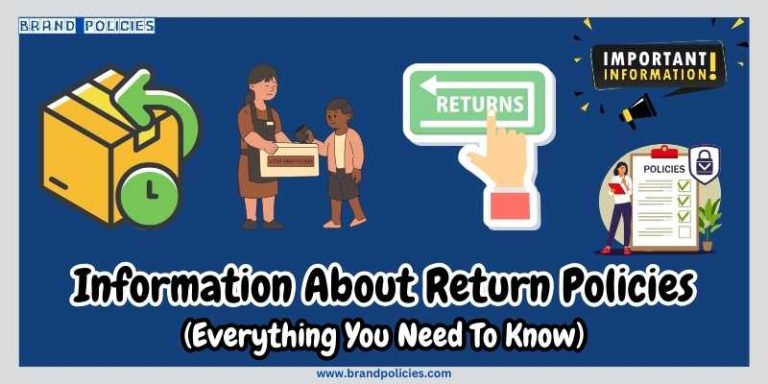Welcome to the basic information about return policies. Shopping, whether online or in physical stores, sometimes results in finding the perfect item on the first try. The world of return policies, often shrouded in mystery, is crucial in ensuring customer satisfaction. This guide aims to unravel the intricacies of return policies, providing you with the knowledge and confidence to navigate them successfully, supported by eye-opening facts and figures.
Decoding The Return Policy: A General Information

Did you know that a whopping 15% of all online purchases end up being returned, as reported by the IMRG? This staggering number emphasizes the significance of having a clear and fair return policy. Beyond mere convenience, a robust return policy is a trust-building exercise, fostering customer loyalty and confidence. Here’s a step-by-step guide:
1. Eligibility Criteria
- Time Frame: Consider the timeframe for returns, which commonly ranges from 30 days to a generous year. Imagine the peace of mind when returning those summer jeans you purchased last year!
- Reasons: Understand the reasons for returns. Shockingly, 22% of apparel returns stem from sizing issues. Make size charts and review your new best friends!
- Exceptions: Be aware of non-returnable items. For instance, 56% of Britons express hesitance to buy from businesses charging for returns, especially for final sale deals or opened hygiene products. Pay attention to the fine print!
2. Navigating The Return Process
- Initiation: Familiarise yourself with the initiation process – whether it can be done online, in-store, or through customer service. Surprisingly, due to simplified online processes, 38% of customers found returns more comfortable during the pandemic.
- Preparation: Ensure you have the original packaging and receipts, as they are often required. Keep in mind that 44% of consumers believe returned merchandise might be resold.
- Fees: Some return processes include restocking fees or deducted return shipping costs. Studies indicate a 50% increase in emissions from shipping returns during the pandemic, emphasizing the environmental impact. Be mindful of these fees!
3. Understanding The Refund Policy
- Methods: Know how you’ll be refunded – whether on your original payment method or through store credit. Remarkably, 88% of consumers are more likely to buy online if returns are free. Businesses, take note!
- Time Frame:Be patient; processing refunds takes time. Expect a range, such as 5-7 business days, to avoid disappointment. A fun fact: 7.5% of online returns are fraudulent. Trustworthiness is crucial for both consumers and businesses.
- Exceptions:Read carefully, as partial refunds for used items or restocking fees might apply. Shockingly, up to 4.3 billion tons of returned items are in US landfills annually. Opt for sustainable purchases and responsible returns!
4. Bonus Tips For a Seamless Experience
- Keep Records: Save receipts and emails for documentation.
- Communicate: Reach out to customer service if questions or issues arise.
- Shop Strategically: Look for stores with generous return policies, especially for significant purchases.
Suggested For You Does Sephora Refill Perfumes?
Types Of Return Policies With Shocking Stats

Shopping can be both online and in-store. Sometimes, you worry about buying the wrong thing. That’s where return policies come in. This guide, with helpful stats, will make understanding and using these policies easy for you.
1. Full Refund Policy
- Description: A complete financial pirouette! This policy guarantees a full refund (minus shipping) upon return, akin to a risk-free shopping extravaganza.
- Benefits:Customers feel protected and empowered to buy freely. Remarkably, 88% of consumers are more likely to buy online if returns are free! However, this generosity can have drawbacks, potentially leading to higher prices. Additionally, up to 4.3 billion tons of returned items end up in landfills annually, emphasizing the importance of sustainable shopping.
- Examples: Some high-end brands, and online giants.
2. Exchange Policy
- Description: Not the right fit? No worries! This policy allows for seamless swaps within the same product category, be it size, color, or model.
- Benefits: A quick step-change towards satisfaction with no refund delays. However, it is limited to the same product family and might not work if you fall in love with something entirely different.
- Examples: Clothing stores, and electronics retailers.
3. Store Credit Policy
- Description: Instead of a cash refund, this policy offers a store credit equal to the purchase price, acting as a shopping voucher for future adventures.
- Benefits: Fosters loyalty and encourages continued shopping within the same store. However, it is less flexible than a refund, confining your spending power.
- Examples: Department stores, beauty brands.
4. Partial Refund Policy
- Description: This policy offers a nuanced approach, providing a partial refund based on the item’s condition or reason for return.
- Benefits: Protects businesses from excessive wear and tear, ensuring fair practices. However, it can be subjective, potentially leading to confusion and disagreements.
- Examples: Some furniture stores, and appliance retailers.
5. Final Sale Policy
- Description: This policy draws a firm line – once purchased, the item stays with you, and returns are not accepted.
- Benefits: Protects businesses from frequent returns on certain items, such as sale deals or perishables. However, it offers little to no consumer protection, requiring careful deliberation before purchase.
- Examples: Seasonal specials, flash sales.
6. Warranty Policy
- Description: Extending the dance beyond the initial purchase, this policy covers repairs or replacements of defective items for a specific period.
- Benefits: Provides peace of mind and extended protection, especially for big-ticket items. However, it may have specific definitions of “defect” and require proof of purchase.
- Examples: Home appliance havens, electronics emporiums.
People Also Search For Famous Footwear Return Policy 2024
Why Companies Offer 30-Day Return Policy: A Closer Look

Companies offer 30-day return policies to give you time. They want you to feel sure about your purchase. If it’s not right, you can change your mind without stress.
1. Customer Satisfaction Boost
- Reduces Buyer’s Remorse: Allowing a 30-day return window gives customers ample time to try out a product, ensuring it aligns with their expectations. This leads to higher customer satisfaction and fosters loyalty.
- Builds Trust: A generous return policy signals the company’s confidence in its products, showcasing a genuine concern for customer satisfaction. This trust-building exercise often encourages repeat purchases.
2. Business Benefits
- Increases Sales: Studies indicate that a clear and lenient return policy can boost sales, as customers are more inclined to make a purchase when they know they can easily return items that don’t meet their needs.
- Improves Inventory Management: Returns offer valuable insights into customer preferences and product performance, aiding companies in refining inventory management and avoiding stocking items likely to be returned.
- Reduces Fraud: The 30-day window acts as a deterrent to fraudulent returns, providing companies the time needed to investigate claims and verify purchases.
3. Industry Standards
- Competitive Pressure: Many industries have established 30-day return policies as the standard. Companies often feel compelled to align with these norms to stay competitive.
- Legal Requirements: Some regions, like the European Union, mandate minimum return periods. For instance, consumers in the EU have a 14-day right to withdraw from online purchases.
4. Additional Considerations
- Return Fees: Companies might charge fees for returns, such as restocking fees or shipping costs.
- Exceptions: Certain items, like clearance or personalized items, may be non-returnable.
- Conditions: Companies may set specific conditions for returns, such as requiring items to be in their original packaging or unused.
In summary, while not all companies adopt a 30-day return policy, those that do benefit from increased customer satisfaction, trust-building, and potential sales boosts. However, each business’s decision should consider factors like product type, target audience, and industry standards. Always review the specific return policy of a company before purchasing to understand any associated fees, exceptions, or conditions.
How Do I Start a Return Policy: Crafting a Customer-Centric Return Policy

Shopping is like a treasure hunt, online or in stores. But what if you get something wrong? Don’t worry! Return policies are like helpful torches, guiding us when we need to send things back. Crafting a policy that works for both businesses and customers is the real win!
Creating a well-defined return policy requires careful consideration and planning. Here’s a guide to help you get started:
The Why We Return
Before penning your policy, understanding the “Why” behind returns is crucial. It’s not just about buyer’s remorse; it’s about building trust and customer satisfaction. Picture a 30-day window to ensure the perfect fit! Studies show this generosity can boost sales by 38% and build loyalty beyond comparison. Did you know that 88% of consumers are more likely to buy online if returns are free? Talk about customer magnets!
Building Your Return Maze
Here’s a guide to help you get started:
1. Decide Your Goal
- Is customer satisfaction your North Star? Aim for generous return windows and clear communication.
- Is business growth your focus? Consider shorter windows with fees for certain items. Remember, legal compliance is always a vital checkpoint.
2. Time-Travel With Timeframes
- 30 days is a popular standard, but the perfect time frame is your personal adventure. Consider product types, industry norms, and the balance between flexibility and potential fraud.
- Up to 4.3 billion tons of returned items end up in landfills annually. Be mindful of unnecessary returns!
3. The Acceptable Reasons
- Defective items are a no-brainer, but what about a change of mind? Offering limited options, perhaps with fees, can strike a balance. Size and fit issues? Detailed size charts and fit guides can be your trusty map. Stat alert: Sizing issues account for 22% of apparel returns. Be your customer’s friendly sizing sherpa!
4. The “Do Not Enter” Signs
- Perishables, hygiene products, and customized items often belong here. Be clear and consistent across your policy and product pages. Did you know? Final sale deals account for 56% of Britons being hesitant to buy. Read those fine-print lines!
5. The Return Journey
- Online portal, in-store options, or a friendly customer service contact? Make the process convenient and transparent. Explain required documentation, packing tips, and associated fees. Fact: During the pandemic, 38% of customers became more comfortable with returns thanks to easy online processes. Embrace digital convenience!
6. The Reward at the End
- Full refunds are golden, offering instant satisfaction. Store credit can encourage future explorations. Partial refunds? Clearly define conditions and potential deductions. Alert: Studies show emissions from shipping returns increased by 50% during the pandemic. Choose sustainable policies and responsible returns!
7. Make it Easy to Navigate
- Prominently link your policy on your website, receipts, and product pages. Use clear language, avoiding legalese. FAQs and customer service support can be your friendly guides.
8. Adapt and Evolve
- Monitor your return rate and customer feedback. Seasonal adjustments or temporary policy changes can be valuable tools. Remember, a fair and evolving policy builds trust and keeps customers coming back for more.
- So, go forth and craft your return policy! With these tips and a focus on customer needs, you can create a policy that shines a light on both satisfaction and business success. Remember, a well-designed return policy isn’t just a safety net; it’s a treasure chest waiting to be opened, filled with loyalty, trust, and a thriving customer base. Happy crafting!
- Embrace the facts and figures, and use them to highlight the importance of a customer-centric policy and the potential gains for both sides. May your return policy maze guide you to customer satisfaction and business success!
Conclusion
In simple terms, creating a return policy is like being a shopping pro. With tips and stats, design a policy that makes customers happy. It’s not complicated; think of it as a smart plan. Be the best at it, going beyond what’s expected. Your return policy is like a gem in customer happiness. You’re not just playing in the retail world; you’re the champion of easy returns. Enjoy making your policy, and keep customers smiling!
If You Want To Know Most Premium Brands Policies Then You Should Must Visit To Our Homepage.

